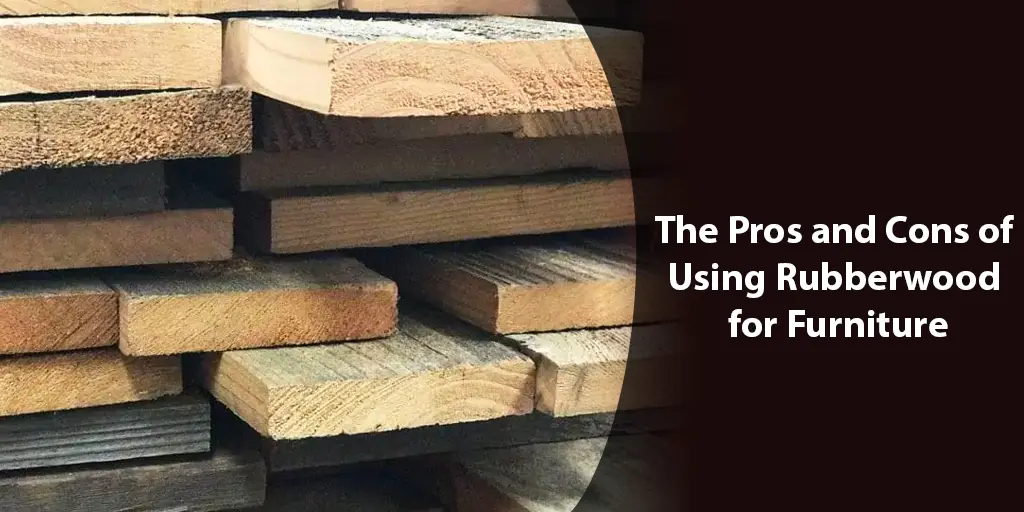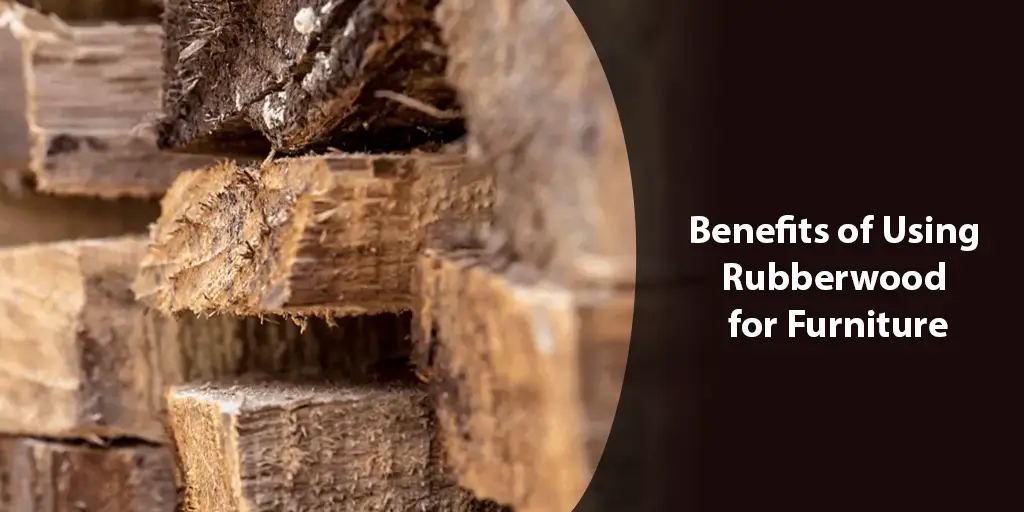Rubberwood is a uniquely sustainable hardwood choice for furniture and woodworking projects.
Also known as Parawood, this durable material comes from the Hevea brasiliensis tree, more commonly called the Pará rubber tree.

Native to tropical regions of South America, Africa, and Asia, the rubber tree has long been cultivated for its latex production.
What many woodworkers may not realize is that rubberwood possesses desirable characteristics for furniture making and construction.
After decades of productive latex harvesting, the rubber tree is felled and its wooden remains are milled into structural lumber.
This ensures rubberwood extraction does not reduce the global rubber supply or encroach on untouched forests. By fully utilizing the rubber tree lifecycle, rubberwood emerges as an eco-friendly hardwood option.
With properties similar to popular woods like ash and maple, rubberwood offers craftsmen and DIYers an affordable alternative.
Its moderate density, resistance to warping and cracking, and light coloration give furniture and projects lasting appeal. Rubberwood also machines and carves with ease.
These traits have contributed to rubberwood’s growing popularity among commercial manufacturers and hobbyists alike.
This guide provides a comprehensive overview of rubberwood’s material properties and suitability for different applications.
Both advantages and limitations will be assessed to help readers make informed choices. Example rubberwood furniture styles and proper care techniques extend the material’s lifespan. Answers to common questions aim to settle user concerns.
By learning more about this sustainable wood’s full potential, builders can find new inspiration for living up to rubberwood’s name – as “wood for woodworking.”
Benefits of Using Rubberwood for Furniture

Durability to Stand the Test of Time
With a Janka hardness rating of 995 lbf, rubberwood demonstrates surprising durability for the price.
Its dense, interlocked grain structure makes it resistant to dents and scratches from daily use. Properly finished rubberwood furniture can withstand decades of wear without noticeable degradation.
Some manufacturers even use rubberwood for high-traffic applications like flooring thanks to its toughness.
A Budget-Friendly Alternative
While offering performance comparable to oak or maple, rubberwood costs less due to its widespread cultivation.
This affordable price point expands design options for households on a budget. Commercial operations also adopt rubberwood to keep production costs low and pass the savings to customers. Its value persists long after purchase.
A Naturally Beautiful Material
Featuring an attractive blonde to golden brown hue with a fine, uniform grain, rubberwood brings visual elegance to any room.
Its light color blends harmoniously into contemporary and rustic aesthetics alike. Over time, rubberwood takes on a warm, lived-in patina that becomes even more handsome.
Ease of Working
Rubberwood’s straight grain and medium-soft texture facilitates fast, chip-free machining on a variety of woodworking tools.
It is a joy for both professionals and hobbyists to shape, cutting minimal effort while producing clean results. These user-friendly traits boost productivity and allow for intricate details.
Dimensional Stability
Rubberwood maintains its size and shape impressively well with changes in moisture—a property appreciated by woodworkers.
Its stable dimension translates to long-lasting fit and function without gaps in joints or warping panel surfaces over the lifetime of a project.
Disadvantages of Using Rubberwood for Furniture
Susceptibility to Pests and Fungi
Like other softwoods, rubberwood is prone to infestation by wood-boring insects like beetles if not properly seasoned and treated.
Its dense pore structure can also harbor fungal stains if exposed to wet environments. However, a quality sealant largely prevents such issues.
Potential for Discoloration
Without a protective topcoat, rubberwood’s pale hue is at risk of darkening or staining from UV exposure, ground contact, or other sources over time.
This natural color shift may not match an owner’s long-term aesthetic vision. Liberal application of a stain or sealant guards against unwanted darkening.
Warp Tendency in Some Conditions
Though fairly stable, rubberwood can still twist or bow if unrestrained soy or wet/dry cycling – especially in regions with monsoon seasons.
Promptly addressing moisture accretion inside wooden components prevents unattractive warp. Periodic reapplication of sealant also acts as a moisture barrier.
Lack of Water Resistance
While rubberwood performs solidly indoors, its porous structure allows water to seep deep inside if used outdoors without impregnation.
This makes it inappropriate for exterior applications prone to dampness like patio furniture without aggressive sealant protection.
Susceptibility to Decay
Much like other softwoods, decay fungi thrive on rubberwood if excessive moisture is consistently present.
Indoor furniture poses little risk, but outdoor pieces demand conscientious sealing, maintenance, and perhaps chemical wood preservatives for durability.
Examples of Rubberwood Furniture
Common Household Styles
Rubberwood versatility and affordability make it an excellent choice for many common household furniture pieces.
Cabinets, shelves, and other built-in furniture provide durable, long-lasting storage and display solutions. Dining tables endure every-day use for entertainment.
Seating Comfort
Chairs, rockers, and benches crafted from rubberwood typically attain a light but sturdy quality. Their rounded edges hold up to continuous contact without bruising. Textured surfaces promote breathability during warm seasons.
Tabletop Options
Bedside tables, coffee tables, desks and more utilize rubberwood’s stability for solid, level work surfaces. Its resistance to water rings and superficial scuffs keeps tabletops looking their best over the long haul.
Specialized Furniture
In specialty woodwork like cutting boards and butchering blocks, rubberwood imparts lasting use plus natural anti-microbial properties safe for food contact. Windows, doors, and flooring gain handsome aesthetic appeal.
Some Common Rubberwood Furniture Styles
| Furniture Type | Intended Use | Rubberwood Benefits |
|---|---|---|
| Cabinets | Storage | Durability, moisture resistance, budget-friendly |
| Dining Tables | Entertaining | Stability, dent resistance, easy to maintain |
| Shelves | Display | Dimensional stability, weight-bearing capacity |
| Seating | Relaxation | Breathability, resilient to daily use |
| Nightstands | Bedrooms | Waterproof surface, carries weight safely |
Is Rubberwood Good for Indoor Furniture?
Used inside the home, rubberwood demonstrates strengths befitting its density at an affordable price point. Its dent resistance, dimensional stability, and workability serve families well through years of indoor use with minimal upkeep.
Whether showcasing contemporary sleekness or traditional charm, rubberwood makes indoor spaces feel complete with a diversity of styles. Its neutral tones match any color palette while bringing visual warmth.
Proper sealing safeguards rubberwood’s patina indoors without buckling under humidity variations like some woods. Infrequent cleaning maintains its fresh look. Gone are worries over water damage weakening joints or warping surfaces.
Free of volatile organic compounds, rubberwood emits no harmful gases into living areas like some cheaper synthetic substitutes. Its plant-based properties support comfortable, eco-conscious indoor living.
Naturally dent-resistant yet lightweight for rearranging, rubberwood handles family foot traffic without showing wear on cabinetry, shelves, or dining tables over years of enjoyment.
In summary, rubberwood’s rigidity, biocompatibility and low demands make it a prime contender for furniture guarding beloved family heirlooms and creating comfortable indoor spaces to call home. Its enduring characteristics prove it “built to last” where livability matters most.
Rubberwood Furniture Care and Maintenance
Regular Protection from the Elements
Resealing rubberwood pieces every 6-12 months shields against indoor moisture, sunlight damage, and dirt penetration to keep them looking their best.
Quality paste waxes form breathable barriers while enhancing the wood’s natural appeal.
Gentle Cleaning is Key
Grime removal with a microfiber cloth and mild soap + water maintains a clean aesthetic without stripping protective natural oils.
Harsh chemicals can degrade the wood over time. Gentle scrubbing removes stubborn marks safely.
Periodic Conditioning is Critical
Applying food-grade mineral or Danish oils rejuvenates dried out wood fibers without altering the existing finish.
This conditioning promotes long-lasting suppleness to prevent cracking or splintering from environmental changes.
Inspect for Pest Deterrence
Checking nooks and crannies aids early detection of potential insect infestations before significant damage.
Natural oils or prompt treatment curtail issues to maintain structural integrity. Prevention outweighs costly repairs.
Consider Replacement When Necessary
Over many years of daily use, natural wear may eventually demand light refinishing or selective board replacement to restore like-new functionality. Skilled refinishing prolongs a piece’s lifetime of service.
With low-effort care, rubberwood endures as a worthwhile investment. Minimal maintenance maximizes its longevity and value through generations of enjoyment. Proper techniques cement its rightful place among noble wood types.
FAQs
How does rubberwood’s durability compare to other woods?
While less durable than tropical hardwoods like teak, rubberwood rivals the durability of ash or maple when properly sealed.
Its density lends resilience surpassing many softwoods. With care, rubberwood furniture can grace a home for decades.
Does rubberwood accept stain easily?
Yes, rubberwood’s open grain readily absorbs oil-based stains for a deep, rich color. It may require additional coats or conditioning to fully saturate the wood.
Its light hue also magnifies subtle hue variations which craftspeople leverage for one-of-a-kind designs.
Will rubberwood furniture scratch or dent?
Like any wood, scratches and dents are possible over time. However, rubberwood’s density makes it less prone than less hardy woods.
coasters protect tabletops while felt furniture leg pads spare floors. With care, most marks can often be minimized or removed.
Is refinishing rubberwood difficult?
No, its straightforward grain accepts sanding well for light refreshes. Scrubbing with fine steel wool eliminates scuffs between full refinishing.
Oil finishes like Danish oil renew luster without obscuring the handsome woodgrain. Pros can address deeper wear or repairs.
Does rubberwood emit VOCs?
In its finished, cured state rubberwood emits low to no volatile organic compounds (VOCs). Some people may still have mild latex allergies to its natural sap but well-seasoned, sealed samples pose minimal risks for indoor air quality.
How do I repair damaged rubberwood?
Minor nicks can be filled with wood putty or wax sticks. Deeper wounds require matching filler and stain, then sanding flush.
Severely damaged areas may necessitate patch replacement. Boiled linseed oil rejuvenates original luster after repairs fully cure. Seek guidance for large defects.
Conclusion
In conclusion, rubberwood offers an appealing marriage of aesthetics and affordability for furniture construction and home décor projects both large and small.
Its moderate weight, strength, workability and sustainability make it an excellent choice for applications from dining tables and bookshelves to window frames and flooring.
While requiring more protection from moisture than some alternative woods, rubberwood presents advantages deserving consideration – especially for those focused on sustainability, accessibility and lifetime value.
With proper sealing and low-effort care, it continues delivering beauty through generations of use.
Whether craving a natural complement to modern interior design or in need of heavy-duty replacements, rubberwood satisfies as a hardwearing, budget-friendly foundation for living spaces. Its multi-purpose potential inspires creative solutions.
Relative ease of repairs also keeps well-built rubberwood pieces looking renewed for many years to come.
In light of rubberwood’s numerous pros, enthusiasts see its modest cons as easy sacrifices. Its renewed popularity in furniture, joinery and building trades signals trust in abilities matched by few alternatives.
As eco-awareness grows, so does appreciation for materials promoting both sustainability and affordability without compromising quality. On these virtues, rubberwood earns its place among premier wood types.



